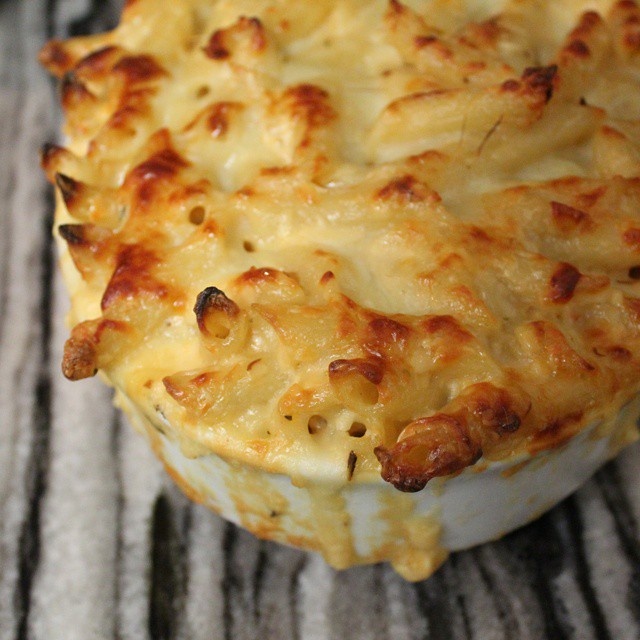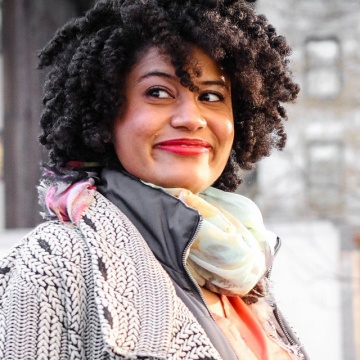Columbia College | Columbia University in the City of New York
Rewriting the Rules of Mac and Cheese, by Robyn Burgess ’10
Every year of my childhood, until I moved away at 17 to attend Columbia, I had two Thanksgiving Day feasts. Both were set in Washington, D.C. Both were hosted by a Black matriarch with a large family and a successful career. Both featured the full Turkey Day spread. But whereas one might conjure images of Soul Food, with familiar Black customs rooted in the South, the other represented a Northern elite identity that embraced trend over tradition. These two celebrations at opposite ends of the Black experience centered my identity and made me the cook I am today.
The differences between them could be tasted in the macaroni and cheese.
We always went to Mommy Edith’s house first. My father and his five older siblings grew up in the tallest brick house on a hill in Southeast, only 15 minutes away from my childhood home. We would arrive around 1 p.m. to find some of my 35 older cousins spilling out from the house onto the front porch and sidewalk. As the afternoon ticked, more aunts and cousins would arrive reliably late with more dishes. The food would be blessed, mothers would fix paper plates for their children, the elders would be helped to seats around the large dining table and the generations in between would take turns eating when there was a free spot on the plastic-lined couch.
The setting was the same every year and so was the menu: turkey, stuffing, meatballs, fried chicken wings, macaroni and cheese, candied yams, potato salad, string beans and collard greens, usually picked from my grandmother’s farmland in Westmoreland County, Va. Each aunt would bring a special dish that she had perfected over the years. I could expect a dish to look and taste a certain way and never be steered wrong.

Burgess’ own mac and cheese, yummmmmm ...
There were hard and fast rules for preparation. If you could taste the milk or butter, whoever made the dish had been stingy and not used enough cheese. Likewise, if the layer of cheese on top was too thin or neglected altogether, its maker was cheap or planned poorly to save enough. You cannot make macaroni and cheese on a stovetop and eat it with a spoon. It’s just not what we do. There’s harsh judgment if you don’t follow the rules — you’re never asked to bring that dish again.
Across town in Northwest, my maternal grandmother and I always stretched those Thanksgiving rules as far as they could go. One year we used a recipe from a magazine to make a macaroni and cheese with four fancy cheeses: fontina, gouda, fresh mozzarella and smoked cheddar. So far detached from our community, this recipe, adapted from a restaurant in Colorado, necessitated my first trip to Whole Foods, to buy the cheeses that weren’t available in the neighborhood Safeway. The dish wasn’t even topped with cheese nor baked firm. Instead, breadcrumbs were sprinkled on top and the dish quickly broiled to a crisp before a garnish of diced tomatoes and basil were added. This new definition of macaroni and cheese, with its play of smoky flavors against the fresh tomato and basil, was eye-opening and tongue-tingling.
At Nana’s Thanksgiving, there was no swell of aunts and uncles and cousins. Usually it was just my nuclear family, my grandmother and her longtime boyfriend around a carefully styled table. We also didn’t have any soul food roots to cling to there. Nana was from Quincy, Mass., the daughter of a successful food purveyor who had immigrated from the Cape Verde Islands. She had attended Howard University, made a family with an architect from Memphis, participated in the Black Arts movement and been a socialite in the D.C. scene of foreign diplomats. For her, there was no dissonance between Black American foodways and gourmet food. She kept company with Black revolutionaries, but exploring beyond oral traditions and using recipes from worldly sources was not disruptive to her identity.
Thanksgiving at Mommy Edith’s grounded me in who I am and where I came from. Thanksgiving at Nana’s house gave me the opportunity to explore my love of cooking by experimenting with new dishes. In my cuisine today, I respect traditional techniques, but bend the rules and play with flavors that are both familiar and exciting. This Thanksgiving, macaroni and cheese will definitely be on the menu. I’ll use a blend of fancy cheeses but bake them under a thick layer of melted cheese. The best of all my Thanksgivings.

SADÉ CLACKEN JOSEPH, BC’11
More “Lion’s Den”
- 1 of 5
- ›

